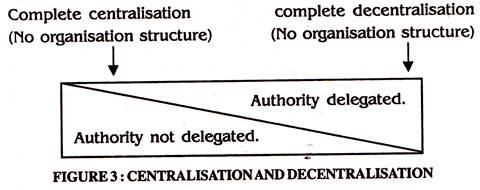After reading this article you will learn about Centralisation and Decentralisation in an Enterprise:- 1. Meaning of Centralisation and Decentralisation 2. Factors Determining the Degree of Decentralisation 3. Advantages of Decentralisation 4. Disadvantages of Decentralisation 5. Advantages of Centralisation.
Meaning of Centralisation and Decentralisation:
Centralisation means that the authority for most decisions is concentrated at the top of the managerial hierarchy and decentralisation requires such authority to be dispersed by extension and delegation through all levels of management.
Organisation authority is merely the discretion conferred on people to use their judgment to make decisions and issue instructions. Decentralisation is the tendency to disperse decision-making authority in an organised structure. It is a fundamental aspect of delegation to the extent the authority is not delegated, it is centralised. How much should authority be concentrated in or dispersed throughout the organisation?
There could be absolute centralisation of authority in one person, but that implies no subordinate managers and therefore no structured organisation. Some decentralisation exists in all organisations. On the other hand, there cannot be absolute decentralisation. Centralisation and decentralisation are tendencies, as indicated in the diagram.
Factors Determining the Degree of Decentralisation:
The degree of decentralisation in an enterprise is determined by a combination of the following factors:
1. Nature of Growth:
If the enterprise than grown through internal expansion, it will continue to retain its original structure until it becomes unmanageable.
2. Outlook of the Top Management:
ADVERTISEMENTS:
If the top management believes in uniformity, or if it seeks unified control, it will prefer strong centralised planning and control. On the other hand, if it has a liberal outlook and believes in individual freedom, it will go in for decentralisation and fewer controls.
3. Size and Dispersal of Operations:
Dividing a small enterprise into a number of divisions may be a costly affair. The best course for it would be to adopt a functional structure with is activities grouped under production, marketing, finance etc. But in a large enterprise with wide dispersal of operations, creation of divisions and departments for different activities and sub activities will add to its efficiency and profitability.
4. Extent of Diversification:
ADVERTISEMENTS:
If the enterprise is dealing in a number of diverse products, it cannot retain its efficiency through functional division of work because the production or sales department would not be able to give equal attention to each of the different products manufactures by it. The alternative in such a case would be to go in for a separate department or division for each product.
5. Nature of Functions:
There should be greater decentralisation of the basic functions. For example production, marketing and finance. The employees engaged in these activities would be encouraged to perform more efficiently.
6. Availability of able Managers:
ADVERTISEMENTS:
Decentralisation will be possible only when middle level managers of the enterprise are capable and experienced enough to make important decisions. Where such managers are not to be found, centralisation and not decentralisation would be more beneficial.
Advantages of Decentralisation:
1. A decentralised organisation structure stresses delegation of decision-making and lightens the load of top managers.
2. The development of generalists rather than specialists is encouraged, thereby facilitating succession into positions of general managers.
3. Intimate personal ties and relationships are promoted, resulting in greater employee enthusiasm and coordination.
ADVERTISEMENTS:
4. Familiarity with important aspects of special work is readily acquired,
5. Efficiency is increased since managers are near the activities for which they are held responsible no trouble spots can be located and remedied easily.
6. Multiunit enterprise keyed to geographic dispersion, full advantage of local conditions can be obtained.
7. Plans can be tried out on an experimental basis in one plant, modified, and proven before being supplied to similar plants of a company.
ADVERTISEMENTS:
8. Risk involving possible losses of personnel, facilities and plants are spread out.
Disadvantages of Decentralisation:
1. Lack of Coordination:
Under decentralisation, each division or department of the enterprise enjoys substantial freedom in the formulation of policies and action plans. This creates a difficult problem of coordination.
2. Costly:
ADVERTISEMENTS:
Only a very large enterprise can afford the high operating costs of maintaining a decentralised set-up. This is because under decentralisation, each division of the enterprise has to be self-sufficient in every respect. This may not only result in duplication of functions, but may also lead to wastage of resources, because often one or the other facility remains under-utilised in each division.
3. Lack of able Managers:
A decentralised enterprise has to depend on divisional managers. But it is difficult to find persons who are adequately equipped to run a division independently.
Advantages of Centralisation:
1. Power and prestige are provided the chief executives.
2. Uniformity of policies, practices and decisions are fostered.
3. Full utilisation of the main office and information specialists is promoted, due in large part to their proximity to the top management level.
ADVERTISEMENTS:
4. Highly qualified specialists can be utilised because the scope and volume of their work are sufficient to support and to challenge top-notch managers.
5. Duplication of functions is minimised.
6. The danger of actions drifting and getting off course is reduced.
7. Elaborate and extensive controlling procedures and practices are not required.
8. A strong coordinated top management team is developed.
